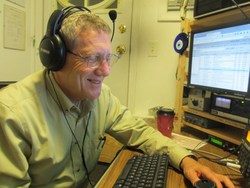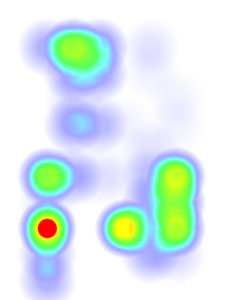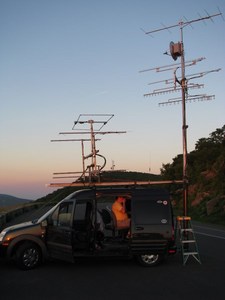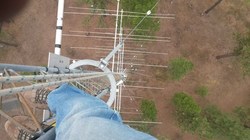 October 22, 2014 Editor: Ward Silver, NØAX | |||||||
IN THIS ISSUE
NEW HF OPERATORS - THINGS TO DO "The most fun you can have on the radio" is often applied to one's favorite contest but you would be hard-pressed to find a more popular contest in radiosport than the CQ World Wide DX Contest. This weekend is the SSB weekend - look for stations from all over the world to be piling in loud and fast. To participate, give out a signal report ("Five nine" will do) and your CQ Worked All Zones program zone. And don't forget the School Club Roundup going on this week through Friday afternoon. BULLETINS CQ Communications has reconsidered its initial policy on stations operating in Crimea for the CQ World Wide contest. Logs will be accepted and counted for the country indicated by the call sign of the station. This aligns CQ policy with DXCC policy. See the CQ website for complete details. BUSTED QSOS Contest dates for the October EU Sprint are the first and second Saturdays. The April EU Sprints are on the first and third Saturdays. (Thanks, Tom WB8ZRL) EMC Blog author Ken Wyatt's call sign is WA6TTY. Thanks, Bob KØNR CONTEST SUMMARY Complete information for all contests follows the Conversation section October 25-26
November 1-2
As we approach November and the ARRL Sweepstakes, don't forget the Clean Sweep mugs for working at least one station in all 83 ARRL/RAC sections. Sweepstakes Participation Pins are also available for anyone completing more than 100 contacts on CW or Phone during Sweepstakes. Each pin displays the year and mode and has become a popular tradition in the November Sweepstakes event. You can find complete ordering instructions and prices on the ARRL Sweepstakes web page. (Thanks, ARRL Contest Branch Manager, Matt W1MSW)
Alright all you Sweepstakes veterans, here's your assignment - help anyone logging on paper get their log converted to Cabrillo format and submitted electronically! I'm sure there are new contesters in your club who are just getting started and aren't ready for contest logging software. They may use a general-purpose logging program and not be aware of how to export a Cabrillo-formatted contest log - help them out! How about others using paper logs who need a hand? You can help there, too, and WA7BNM's Cabrillo converter web service is the way to go! By getting logs submitted electronically, the quality of the log checking process is improved and the provisional results can be published more quickly. Jim AD1C reports that the country (CTY) files, used by logging software to cross-reference call signs and countries, were updated on 13 October 2014. If you are interested in a bigger CTY.DAT for everyday logging, you can download that, too. Please do that before CQ WW SSB begins! The CWops group will be featuring a Very Special Slow-Speed CWops Test on 12 November. The 20 wpm-and-under event is targeted at the new and enthusiastic CW Academy graduates -- help make them feel welcome and eager to come back for more. InnovAntennas America announces North American availability of the G/T - Optimized Wideband Low-impedance High Gain Yagi Antennas, or OWL G/T for short. OWL G/T antennas are optimized for weak signal VHF applications including EME (moonbounce), meteor scatter, and other demanding modes; applications where both antenna gain and control of side and rear lobes are critical to lower the antenna's equivalent temperature by reducing received noise, hence the 'G/T' model suffix.
If you haven't checked out the DX Heat website lately, you might want to take a look at the various interesting displays and presentations of "what's happening now" on the bands. (Scroll down on the home page to see the information below the large photo.) The site features a simple-to-use but flexible incoming spot filter interface, a band activity map, the ability to listen to any spot on a Web-based SDR, and more. The November 2014 issue of Popular Science includes "Dawn of the Data Age," a thought-provoking article about visualization of data. The several examples presented are interesting and eye-catching. Perhaps one of the Contest Update readers might find the techniques inspiring to try building some radiosport data visualizations. It was sixty years ago today that transistors began to play! Well, sixty years from October 18th, the day on which Texas Instruments announced the first transistorized radio. Web Site of the Week - Who are these "lesser known but important engineers"? It's a good bet that at least one of the names will be familiar to many hams. You might be surprised at these tales of invention and accomplishment from EDN magazine. WORD TO THE WISE The Golden Age of Ham Radio -- the five-year period centered on when you got your license: Everything before then was a primitive wasteland and everything after that has been going to h**l in a handbasket! Ralph Fedor KØIR has posted a very interesting video to YouTube that introduces newcomers to DXing, DXpeditions, and Amateur Radio in general. (Thanks, Daily DX) An example of the ordeals Cubesats must go through to qualify for launch, this video (it's a 1Mb file) shows a vibration test on a power supply board. It failed before getting to the 22G requirement! The editor would probably fail at the 22G requirement, as well. (From Bob WB4APR via AMSAT bulletin ANS-292)
Paul WØRW found a website for searching old radio magazines with two million pages for your browsing pleasure! Hams might appreciate this map of the WOM HF-transmit antenna farm operated by AT&T for many years in Pennsuco, Florida, west of Miami. This was one of three high-seas ship-to-shore and island telephone service stations. WOM's corresponding receive site was in Plantation, near Fort Lauderdale. When it was decommissioned the transmission facility sported 38 log-periodics, rhombics and omni verticals over a half-square-mile of Everglades, each of which could handle 10kW from any of 20 or so mostly-Collins transmitters. (Thanks, Tom Becker, ex-KN3URO) The ARRL's Sweepstakes contest manager, Larry K5OT, has just completed researching the history of the Affiliated Club competition for a comprehensive article that will be published in early 2015. Until 1978, all ARRL-affiliated clubs competed in one group and the large clubs dominated the standings. In early 1978, the ARRL Board of Directors approved a three-tiered competition to allow clubs of about the same size to compete against each other. These revised rules were first used in the 1978 Sweepstakes. For this 36-year 'modern era' from 1978-2013, the SS affiliated-club record holders are: Unlimited Category (51 or more logs)
Medium Category (11 through 50 logs)
Local Category (3 through 10 logs)
Maybe your club would like to take a run at these records? Anyone with interesting stories about past club activities in Sweepstakes should contact K5OT.
The full-sized results writeup of the ARRL June VHF Contest by Bob K2DRH is now online - thanks, Bob! Line scores are being worked on and should be available soon. Check your mailbox because ARRL certificates and plaques for the 2013 November Sweepstakes are arriving just in time to whet your contest whistle. Plaques for the 2013 International DX contest are headed out, as well, catching up with the participation pins mailed out last month. Awards for last year's Phone Sweepstakes and IARU HF Championship are next on the list. (Thanks, ARRL Contest Branch Manager, Matt W1MSW) Official results for the 2014 EU HF Championship are now ready, verified by the SCC Contest Committee, and published on the SCC web page. All UBN reports are publicly available as usual and downloadable certificates are also ready. (Thanks, SCC Contest Manager, Robert S57AW) The results for the 2014 Summer Stew are now online. Congrats to NO3M on submitting a golden log (no errors) and just edging out KV4FZ for top high power honors. K1LT led the way for the low power scores and AC8AP led the list of six brave souls who showed up with QRP. (Thanks, Tree N6TR) Raw scores for the 2014 CQ World Wide RTTY Contest are now posted online. (Thanks, Mark N2QT) OPERATING TIP To save your voice during a 48-hour phone contest, set up your transceiver and speech processing to work at low volume levels, then discipline yourself to speak softly - even in those nasty Sunday-afternoon pileups! Also try to minimize sound levels in the shack, such as from fans or blowers, that will be picked up by a speech processor and their noise added to your voice. Winner of the 2014 ARRL Technical Innovation Award, Warren NRØV, has posted a presentation on Digital Predistortion he gave at Ham Radio Friedrichshafen this year. Author of the openHPSDR program's pre-distortion software, he hopes that bringing this commercial wireless ability to the ham bands will help clean up our signals. As he notes, "(It's) no problem to correct an entire amplifier chain at legal limit. No extra hardware or software is required -- one just feeds back a sample of the output from the last stage to calculate the correction." As we move beyond our purely analog, 13.8 V transceiver output amplifiers, adapting this technology provides some clear benefits at relatively little expense. Who knows - maybe someday we'll be able to hear all that receiver performance we pay for! Gary K9AY checks in with an update of his popular low-band receiving loop. "I've done a lot of analysis and experiments over the past couple years that are not yet published. Among the results is a better understanding of the role of ground. I now recommend a few radials for all installations: a minimum of (4) and preferably (8) radials that are twice as long as the loop's footprint. If you add them to an existing system, remember that the resistor should be readjusted for deepest null." Pete N6ZE found this online site that calculates Grid Locators to ten characters and also provides the distance and bearing between them. EDN magazine published this collection of articles about capacitors - don't bypass it! Capacitors can be surprisingly complex and there are more types of them than ever, with each having a special set of characteristics. While you're at the EDN website, read this blog entry about an engineer (re)discovering superheterodyne image response! If you need an outdoor grease that won't attract dust and grit, Mike KD5KC recommends Super Lube. This silicone-based, Teflon-impregnated lubricant might be just the thing for tower winches, bearings, and other exposed uses.
You think you're an Excel power user? While searching for an Excel spreadsheet to perform FFT calculations - without using the built-in Fourier analysis capability - Brian K1LI happened onto Excel Unusual, "A Blog for Applied Science, Engineering and Games in Excel." The list of topics applicable to ham radio is too long to repeat here, but it's a treasure trove of helpful tools. Robert Dehoney found this useful collection of downloadable graph paper images (such as Smith Charts and lin-log axes) and "cheat sheets" for algebra, trigonometry, geometry -- even calculus. Check out this cross-section of a serious cable - do you think it's rated for direct burial? (Thanks, Dennis N6KI) Technical Web Site of the Week - What connector is that, anyway? The wireless world has moved quite beyond the UHF/BNC/N world so Pasternak has prepared this connector identifier chart. Be flummoxed no more! Only Radio Waves Need to Be Polarized (Note that the following is the author's personal opinion, as are all Contest Update editorials.) Lots of discussion has followed CQ Communications' announcement that logs would not be accepted from stations in the Crimea for the upcoming CQ World Wide Phone Contest if they used Russian-issued call signs. As of publication time for this newsletter, the policy has been revised to align with the DXCC policy of using the call sign to determine the country for which the contact will count. While I understand the multiple layers of politics involved with the original decision, we should all reflect on the introduction of such things into Amateur Radio. In whatever form, basing our policies on political considerations is a Bad Thing and will only lead to more Bad Things, especially if it initiates a destructive tit-for-tat escalation. It is a Good Thing that CQ reconsidered and CQ World Wide will run as it always has - everybody works everybody. Ham radio organizations and contest sponsors should always do their utmost to insure that all amateurs are fully welcome to participate in ham radio events and achievement programs, regardless of political issues of the day. This is one of Amateur Radio's great strengths, the fifth pillar of our Basis and Purpose as stated in FCC Part 97.1(e) - "Continuation and extension of the amateur's unique ability to enhance international goodwill." Consider that throughout the Cold War, hams communicated across the Iron Curtain as DXers, ragchewers, contesters, and above all, friends. One of the great delights we all experienced at the first WRTC in 1990 was that of long friendships developed through Amateur Radio finally turning into face-to-face greetings, overcoming decades of political isolation. Having personally helped make those meetings possible, I hope we continue to avoid placing obstacles in the way of amateurs contacting each other.
Crimean hams will, of course, operate with whatever call sign they feel appropriate - whether it begins with U or R. Those of us outside the Crimea should work them just like any other station, neither seeking or shunning them. A QSO is a QSO is a QSO. Hams should act as we always have and ignore the politics. As long as we are licensed, and not legally prohibited from doing so, work each other enthusiastically and often. We'll worry about the point-counting and award programs later. Leave the politics at the power switch, whether it's on your VHF/UHF handheld or a full-gallon HF linear. Our radio waves may be polarized but hams don't have to be. October 22 through November 4 An expanded, downloadable version of QST's Contest Corral in PDF format is available. Check the sponsor's Web site for information on operating time restrictions and other instructions. HF CONTESTS ARRL November Sweepstakes--CW, from Nov 1, 2100Z to Nov 3, 0300Z. Bands (MHz): 1.8-28. Exchange: Serial, category, call, check, ARRL/RAC sec. Logs due: Nov 18. Rules SKCC Straight Key Sprint--CW, from Oct 22, 0000Z to Oct 22, 0200Z. Bands (MHz): 1.8-28, 50, Monthly on the 4th Wednesday UTC. Exchange: RST, S/P/C, name, SKCC number. Logs due: 5 days. Rules CQ World Wide SSB Contest--Phone, from Oct 25, 0000Z to Oct 26, 2359Z. Bands (MHz): 1.8-28. Exchange: RS and CQ zone. Logs due: 5 days. Rules Haunted Lighthouse QSO Party--Phone,CW,Digital, from Oct 31, 0000Z to Nov 2, 2359Z. Bands (MHz): 1.8-28, 50,144. Exchange: Serial or ARLHS number. Rules IPA Contest--Phone,CW, from Nov 1, 0600Z - See website. Multiple time periods. Bands (MHz): 3.5-28. Exchange: RST and serial or "IPA" and state. Logs due: Dec 31. Rules Ukranian DX Contest--Phone,CW, from Nov 1, 1200Z to Nov 2, 1200Z. Bands (MHz): 1.8-28. Exchange: RST and serial or Ukraine oblast. Logs due: 30 days. Rules Himalayan Contest--Phone,CW, from Nov 1, 1200Z to Nov 2, 1200Z. Bands (MHz): 3.5-28. Exchange: RS(T) and Indian state or power. Logs due: Nov 30. Rules Radio Club of America QSO Party--Phone, from Nov 1, 1700Z to Nov 2, 0500Z. Bands (MHz): 3.5-21. Exchange: RST, QTH, name, equipment. Rules Collegiate ARC Championship--CW, from Nov 1, 2100Z to Nov 3, 0300Z. Bands (MHz): 1.8-28. Exchange: See ARRL Sweepstakes. Rules DARC 10-Meter Digital "Corona"--Digital, from Nov 2, 1100Z to Nov 2, 1700Z. Bands (MHz): 28. Exchange: RST and serial. Logs due: 2 weeks. Rules OK1WC Memorial Contest--Phone,CW, from Nov 3, 1630Z to Nov 3, 1730Z. Bands (MHz): 3.5, 7. Weekly on Monday, see website for bands. Exchange: RS(T) and serial. Logs due: 5 days. Rules ARS Spartan Sprint--CW, from Nov 4, 0200Z to Nov 4, 0400Z. Bands (MHz): 3.5-28. Monthly on the first Monday evening local time. Exchange: RST, S/P/C, and power. Logs due: 2 days. Rules VHF+ CONTESTS Haunted Lighthouse QSO Party--Phone,CW,Digital, from Oct 31, 0000Z to Nov 2, 2359Z. Bands (MHz): 1.8-28, 50,144. Exchange: Serial or ARLHS number. Rules LOG DUE DATES October 22 through November 4
ARRL Information Click here to advertise in this newsletter, space subject to availability. Your One-Stop Resource for Amateur Radio News and Information ARRL membership includes QST, Amateur Radio's most popular and informative journal, delivered to your mailbox each month. Subscribe to NCJ - the National Contest Journal. Published bimonthly, features articles by top contesters, letters, hints, statistics, scores, NA Sprint and QSO Parties. Subscribe to QEX - A Forum for Communications Experimenters. Published bimonthly, features technical articles, construction projects, columns and other items of interest to radio amateurs and communications professionals. Free of charge to ARRL members: Subscribe to The ARRL Letter (weekly digest of news and information), the ARES E-Letter (monthly public service and emergency communications news), Division and Section news -- and much more! ARRL offers a wide array of products to enhance your enjoyment of Amateur Radio. Visit the site often for new publications, specials and sales. Donate to the fund of your choice -- support programs not funded by member dues! Reprint permission can be obtained by sending email to permission@arrl.org with a description of the material and the reprint publication. ACKNOWLEDGEMENTS ARRL Contest Update wishes to acknowledge information from WA7BNM's Contest Calendar and SM3CER's Contest Calendar.
| |||||||












